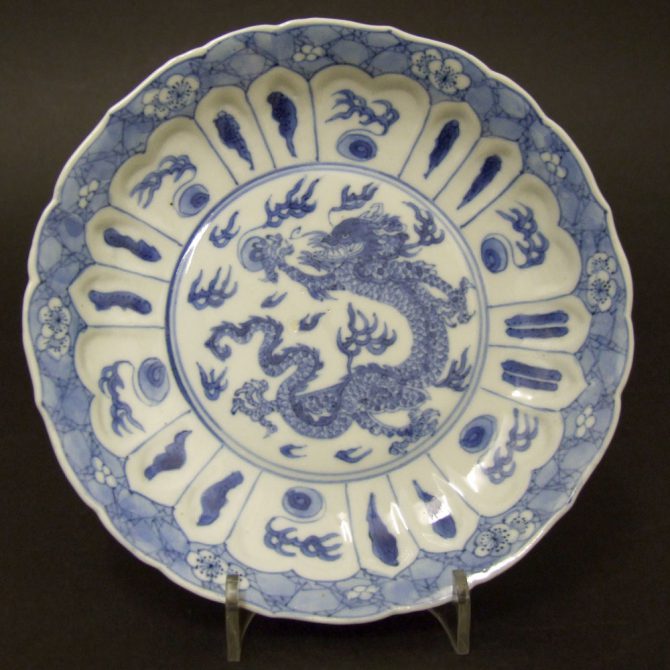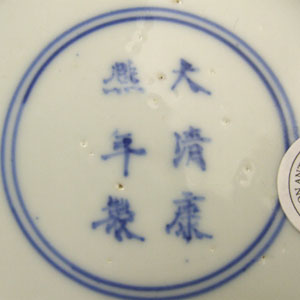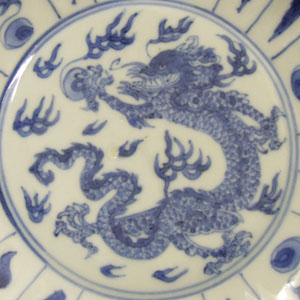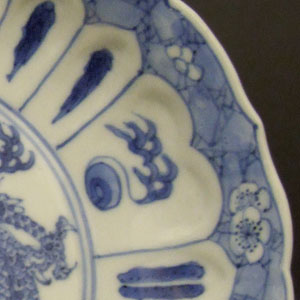
KANGXI 1662 – 1722 Mark and of the Period
A Small Kangxi Blue and White Porcelain Dish, Six Character Minyao Mark and of the Period. The Center Painted with a Four Clawed (None-Imperial) Dragon. The Rim Painted with Plum (Prunus) Against Cracked Ice.
SOLD
- Condition
- Perfect.
- Size
- 15.5 cm (6 1/8 inches).
- Provenance
- N/A
- Stock number
- 22236
- References
- For a very similar Kangxi mark and period dish of this size and design see our `Sold Items` number 22235.
Information
Minyao is a term used for none Imperial porcelain.
Superficially this piece might appear to be part of an imperial order, it show the dragon, the archetypal Chinese imperial symbol, it also has the six character mark of the the emperor himself. However there are many clues to tell us this is not the case. The dragon does not possess the requisite five claws which would give it imperial status, also the drawing of the mark is certainly not of imperial quality. Indeed, the quality of the piece itself is not imperial, but typical of a range of Chinese export porcelain produced during the latter part of the 17th and the early years of the 18th century.
Reign Marks on Kangxi Blue and White Porcelain :
Kangxi blue and white export porcelain object are sometimes found with the six character mark of the emperor Kangxi (1662-1722) to the base. These none-imperial reign marks are referred to as minyao in Chinese, denoting them as `popular wares` not destined for court use. However the majority of the marked pieces bare the mark of earlier Ming dynasty emperors, some are Jiajing (1522-1566), occasionally Wanli (1573-1620) but by far the most commonly encountered marks are those of Chenghua (1465-1487). David Howard in `The Choice of the Private Trader` (David S. Howard, Zwemmer, 1994) notes that "The Chenghua mark .... was not intended as a forgery, but rather as a compliment to the quality of the piece and to replace the mark of Kangxi who had forbidden the use of his name on porcelain made for export after 1682; a ban which nominally remained in force until the late 19th century". It appears this ban was not enforced, or if it was only partly enforced, as we have had many Kangxi export pieces made after this date (1682) that bare the six character Kangxi mark. It is worth noting that many 19th century copies of Kangxi blue and white porcelain bare a four character Kangxi mark, something you do not on the original, all Kangxi marks on porcelain of the period were of six character form.
Dragon :
The Dragon is synonymous with China, it permeates every part of Chinese culture from popular folklore, art, religion to the emperor of China himself. Dragons have been depicted since earliest times. The Dragon, although strong, is in China a benevolent, even positive beast, potent with auspicious powers said to control the Earth and the Heavens. It is associated with life giving rain that nourish crops. This connection with rain and indeed all forms of water could be due to some folklores that says the Dragon is based on the now extinct salt-water crocodile that used to inhabit the rivers of China. The earliest depictions of Dragons in China are so far recorded as being from the Yangshao culture in Henan in the fifth millennium BC from. The five-claw Dragon is reserved as a symbol of the Emperor.
Plum and Cracked-Ice :
Plum Meihua is one of the most important plants in Chinese art. Their flowers grow on knurled old angular branches, the flowers are fragile and pure, so they can be a symbol of vigour in old age as well as purity. The tree is the first to flower after the long hard winter, symbolically it can represent perseverance as well as renewal. This meaning is enhanced by a background of cracked-ice, the design can be seen as representing the end of winter and the beginning of spring with the ice of winter cracking to reveal a new year dawning. Branches of plum blossom convey the `Five Blessings` Meikai wufu, longevity, wealth, health, love of virtue and a peaceful death. The number five, an auspicious number to the Chinese, is taken from the five petals of the plum flower. The design is shown as single plum blossom flowers scattered over cracked-ice or flowering plum blossom branches against the cracked surface of the ice. Jars, especially the so-called ginger-jars or Hawthorn jars , decorated with this design were very popular in England during the end of the 19th and the early years of the 20th century. Kangxi blue and white porcelain in general was highly sought at the time. It was made famous by the artist Whistler among others, and became a symbol of the Aesthetic movement. Prices for this type of Chinese blue and white porcelain, in real terms, reached far more than it would do today.



